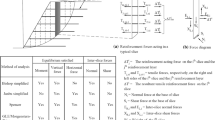Abstract
In order to evaluate the seismic stability of reinforced soil walls against bearing capacity failure, the seismic safety factor of reinforced soil walls was determined by using pseudo-dynamic method, and calculated by considering different parameters, such as horizontal and vertical seismic acceleration coefficients, ratio of reinforcement length to wall height, back fill friction angle, foundation soil friction angle, soil-reinforcement interface friction angle and surcharge. The parametric study shows that the seismic safety factor increases by 24-fold when the foundation soil friction angle varies from 25° to 45°, and increases by 2-fold when the soil-reinforcement interface friction angle varies from 0 to 30°. That is to say, the bigger values the foundation soil and/or soil-reinforcement interface friction angles have, the safer the reinforced soil walls become in the seismic design. The results were also compared with those obtained from pseudo-static method. It is found that there is a higher value of the safety factor by the present work.
Similar content being viewed by others
References
FHWA-NHI-00-043. Mechanically stabilized earth walls and reinforced soil slopes, design and construction guidelines [S]. Washington, DC, US: Department of Transportation, Federal Highway Administration (FHWA), 2001.
BASHA B M, BASUDHAR P K. Pseudo static seismic stability analysis of reinforced soil structures [J]. Geotechnical and Geological Engineering, 2010, 28(6):745–762.
CHOUDHURY D, NIMBALKAR S S, MANDAL J N. External stability of reinforced soil walls under seismic conditions [J]. Geosynthetics International, 2007, 14(4): 211–218.
STEEDMAN R S, ZENG X. The influence of phase on the calculation of pseudo-static earth pressure on a retaining wall [J]. Geotechnique, 1990, 40(1): 103–112.
ZENG X, STEEDMAN R S. On the behaviour of quay walls in earthquakes [J]. Geotechnique, 1993, 43(3): 417–431.
CHOUDHURY D, NIMBALKAR S S. Seismic passive resistance by pseudo-dynamic method [J]. Geotechnique, 2005, 55(9): 699–702.
CHOUDHURY D, NIMBALKAR S S. Pseudo-dynamic approach of seismic active earth pressure behind retaining wall [J]. Geotechnical and Geological Engineering, 2006, 24(5): 1103–1113.
CHOUDHURY D, NIMBALKAR S S. Seismic rotational displacement of gravity walls by pseudo-dynamic method: Passive case [J]. Soil Dynamics and Earthquake Engineering, 2007, 27(3): 242–249.
NIMBALKAR S S, CHOUDHURY D. Sliding stability and seismic design of retaining wall by pseudo-dynamic method for passive case [J]. Soil Dynamic Earthquake Engineering, 2007, 27(6): 497–505.
GHOSH P. Seismic passive earth pressure behind non-vertical retaining wall using pseudo-dynamic analysis [J]. Geotechnical and Geological Engineering, 2007, 25(6): 693–703.
GHOSH P. Seismic active earth pressure behind a nonvertical retaining wall using pseudo-dynamic analysis [J]. Canadian Geotechnical Journal, 2008, 45(9): 117–123.
GHOSH S. Pseudo-dynamic active force and pressure behind battered retaining wall supporting inclined backfill [J]. Soil Dynamics and Earthquake Engineering, 2010, 30(11): 1226–1232.
WANG Kui-hua, MA Shao-jun, WU Wen-bing. Pseudo-dynamic analysis of overturning stability of retaining wall [J]. Journal of Central South University of Technology, 2011, 18(6): 2085–2090.
DAS B M, RAMANA G V. Principles of soil dynamics. 2nd Ed [M]. Connecticut: Stamford, Cengage Learning, 2010: 1–563.
PRAKASH S. Soil dynamics [M]. New York: McGraw-Hill Book Company, 1981: 1–450.
SHUKLA S K, GUPTA S K, SIVAKUGAN N. Active earth pressure on retaining wall for c-ϕ soil backfill under seismic loading condition [J]. Journal of Geotechnical and Geoenvironmental Engineering, 2009, 135(5): 690–696.
SHUKLA S K. Dynamic active thrust from c-ϕ soil backfills [J]. Soil Dynamics and Earthquake Engineering, 2011, 31(3): 526–529.
SHUKLA S K, HABIBI D. Dynamic passive pressure from c-ϕ soil backfills [J]. Soil Dynamics and Earthquake Engineering, 2011, 31(5/6): 845–848.
RICHARDS R, ELMS D G, BUDHU M. Dynamic fluidization of soils [J]. Journal of Geotechnical Engineering, 1990, 116(5): 740–759.
Author information
Authors and Affiliations
Corresponding author
Rights and permissions
About this article
Cite this article
Ruan, Xb., Sun, Sl. Seismic stability of reinforced soil walls under bearing capacity failure by pseudo-dynamic method. J. Cent. South Univ. 20, 2593–2598 (2013). https://doi.org/10.1007/s11771-013-1773-7
Received:
Accepted:
Published:
Issue Date:
DOI: https://doi.org/10.1007/s11771-013-1773-7




